If today we can see the Basilica of the Nativity in Bethlehem lifted from decay, neglect and the ravages of time, it is thanks to an Italian company that has recovered this monument, one of the most important and most symbolic in all of Christendom: from 2013 to 2020, in fact, the basilica was the subject of a long and complex restoration project that involved both the exterior and the interior. A demanding, painstaking and patient work that was carried out by the Italian restoration company Piacenti SpA based in Prato and that was made possible thanks to the initiative of the National Authority of Palestine, which in 2010 managed to come to an agreement with the three Christian communities that manage the Basilica (Orthodox, Catholic and Armenian) to start the process that led to the start of the restoration three years later.
Over the centuries, as early as the 15th century, the Basilica built on the site where Jesus is believed to have been born has suffered various vicissitudes from both human and natural causes that led to its slow decline: in 1450 a major earthquake struck Bethlehem; in 1516 the army of Suleiman the Magnificent conquered Palestine; and in this context the marble slabs and the lead roof covering were stolen by soldiers who used these elements to make their own ammunition for their arquebuses (during the recent restoration many lead bullets were even found inside the faces of the angels and sacred figures depicted in the Basilica, presumably fired by the arquebuses of the Ottoman soldiers). In the nineteenth century, the silver star in the grotto indicating the place where the Child was born was also stolen; then again an earthquake in 1834 caused mosaics to fall, and a century later, in 1934, another earthquake shook Palestine; in addition, damage was caused by rainwater running down the walls and smoke from the many candles that had been lit for years and years in the building. The last blow dealt to the holy place occurred in 2002, when the Basilica saw forty days of clashes between Israeli soldiers and 240 Palestinians seeking refuge inside. These wounds have been partly remedied by a number of restorations, including the one carried out in the 15th century thanks to the guardian father Giovanni Tomacelli, the one carried out in 1842 at the initiative of the Greek Orthodox, and the one following the 1934 earthquake that led to the intervention of the English archaeologist William Harvey, during which the floor mosaics of the Basilica of Constantine were brought to light. However, explains art historian Michele Bacci, “for centuries, restoration work has been made difficult by the fact that the ability to intervene and do even just maintenance work has traditionally been perceived as a means of asserting hegemony on the part of individual communities; those who were able to restore a part of the basilica claimed in this way that they were also its owners. For this reason, the restoration turns out to be an extraordinary occasion in which a true miracle was essentially worked: the three communities, for the first time in history, agreed on the need and urgency to intervene with an overall restoration beyond the traditional differences and disagreements.” Thus, a comprehensive intervention was necessary in order not to let the building fall forever into ruin: consider that it had already been included in the UNESCO list of endangered properties.
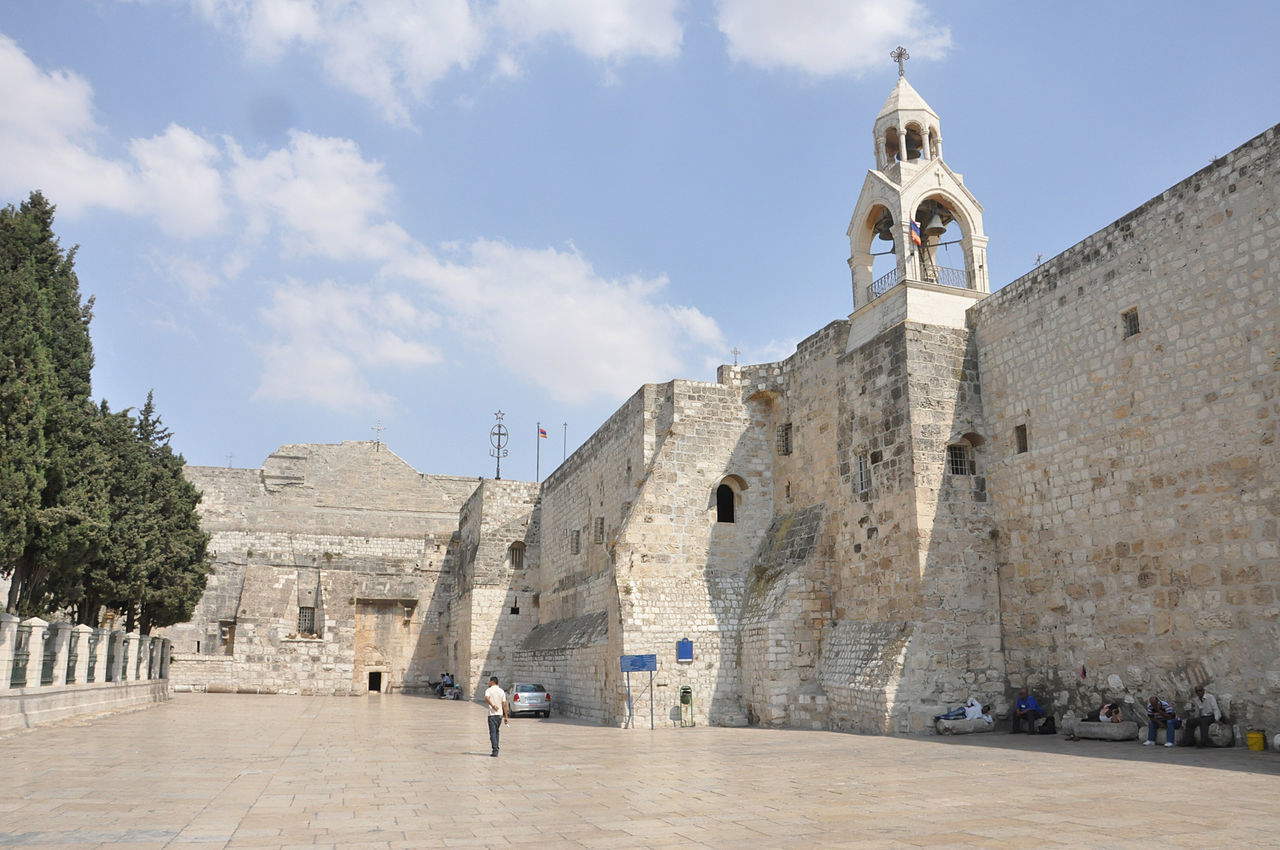



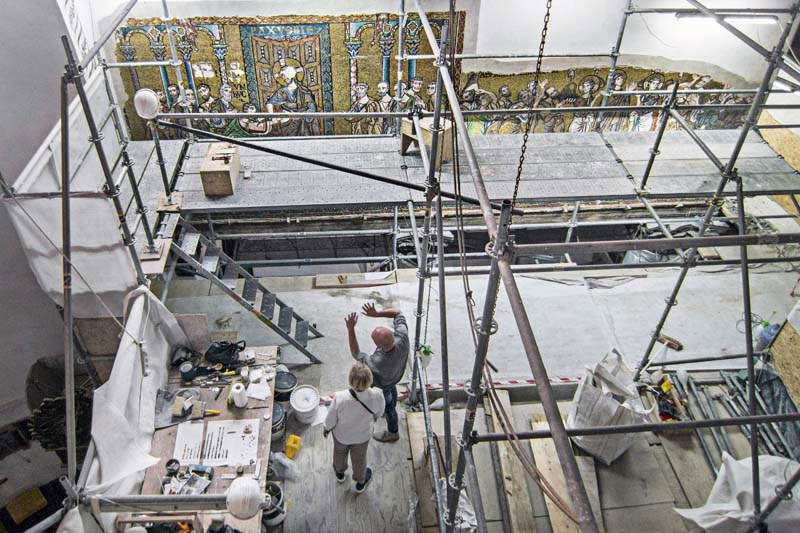
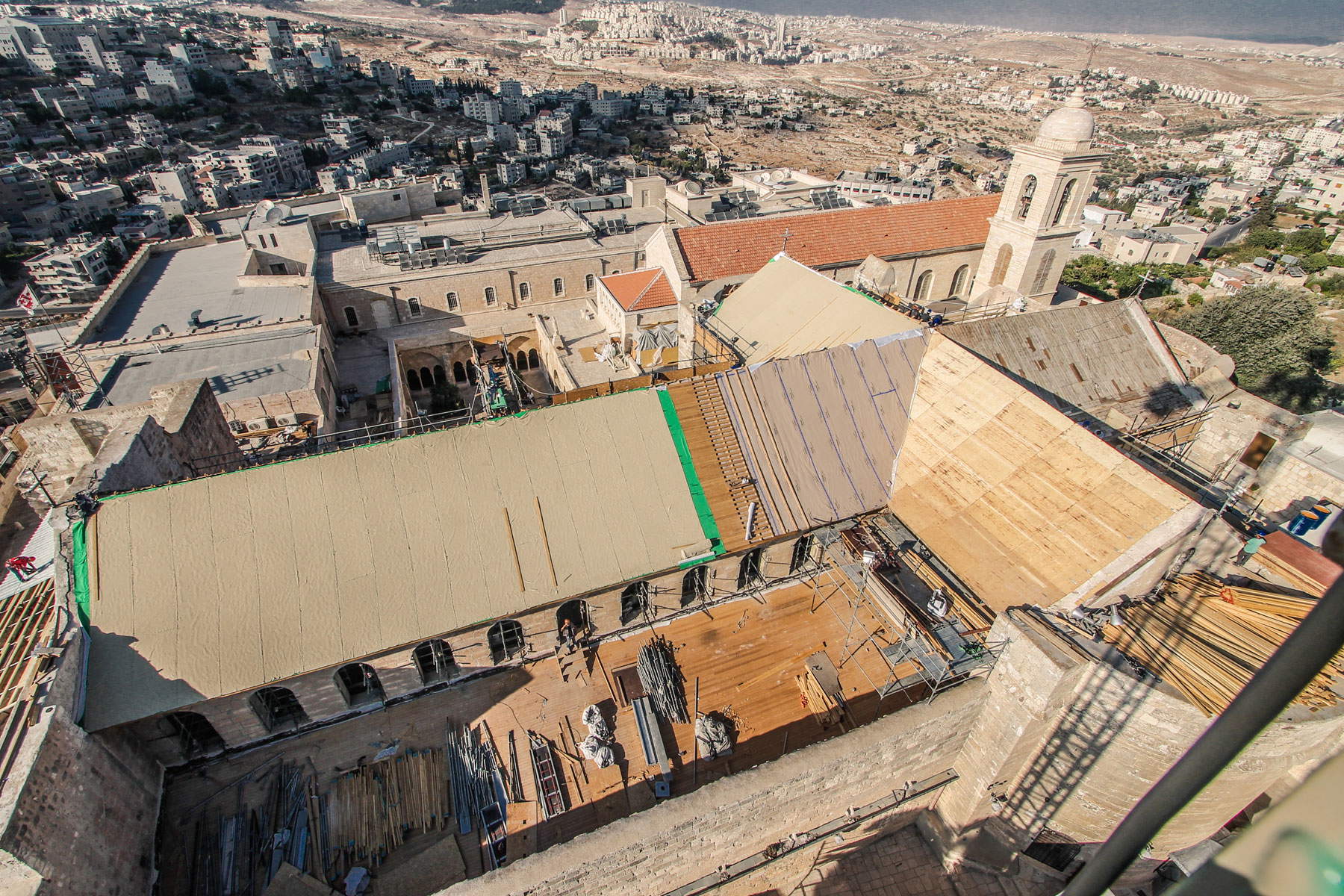
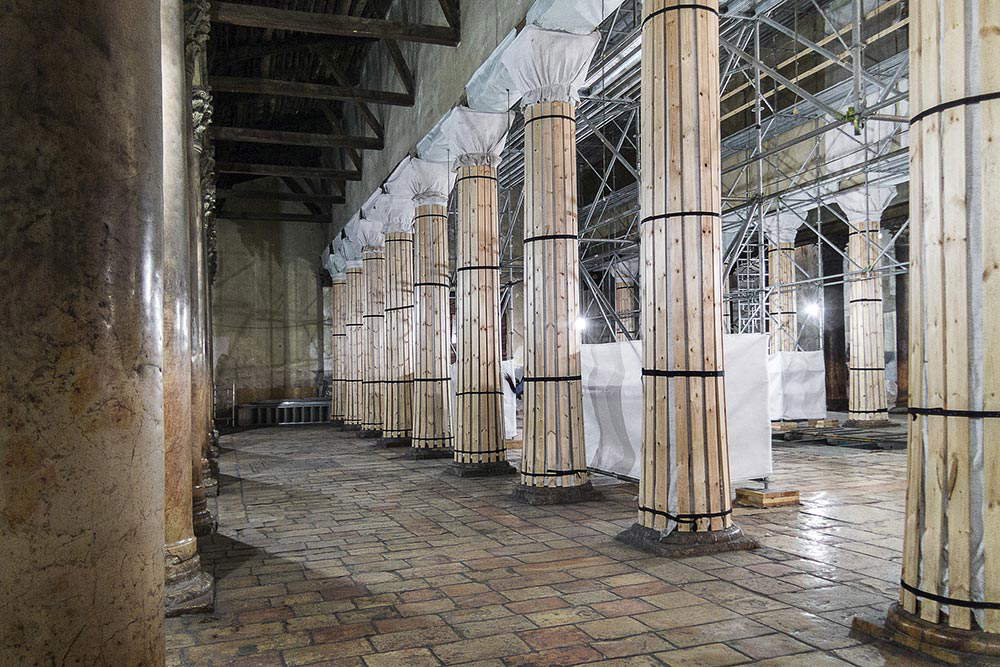
“This basilica,” points out Giammarco Piacenti, managing director of Piacenti SpA, “came down to us being born 1700 years ago, and in the last 150 years it has not had proper maintenance, it has not had works that could preserve it from all this degradation. The conditions were disastrous from so many points of view, starting with the direct water damage on so many elements (on the wood, on the plaster, on the mosaics)... no one stopped this terrible degradation.”
The establishment of a Committee for the Restoration of the Basilica in 2018 kicked off the restoration project, which continued the following year with an international competition aimed at defining the work, eventually entrusted to Piacenti SpA, which along the seven years of work employed 170 people working in various capacities on the monument.The work actually began in 2013 from the part in urgent need of intervention, namely the lead roof, through which it rained inside the building and consequently on the wall mosaics. A wooden beam structure had been built under the masonry that was innovative for the Byzantine period as it was a forerunner of modern earthquake-resistant structures: the restoration of this complex structure required the use of specific beams found in Italy and the reuse of the original nails, while the layer of straw between the wooden beams and the lead slabs was replaced by Prato wool to eliminate condensation and thus thermally insulate the Basilica. The restorers from Piacenti SpA then proceeded to replace the Tuscan cypress and double-glazed windows with ultraviolet and infrared protection to maintain the interior paintings, and to consolidate the roofing vaults of the narthex: the latter proved to be the most complex intervention of the structural part, which made it possible to stop the movement of the facade wall and the collapse of the vaults, and above all to restore the Armenian portal dating back to 1227 placed in the space of the narthex.
Of the approximately 2,000 square meters of wall mosaics that originally decorated the interior walls of the Basilica, only 130 square meters have come down to us, including the nave, transepts and apse, but these are entirely original: despite candle smoke, earthquakes and even vandalism (evidenced, as mentioned above, by bullets found inside the mosaic surfaces and fired by Ottoman soldiers), the restoration completed has restored all the remaining scenes to new legibility. In the course of the work on the mosaics, an extraordinary discovery was also made: six angels were depicted between the windows of the north aisle, one behind the other, accompanying the pilgrim to the holy grotto, but in fact, thanks to thermography, a seventh angel emerged, between the fifth and sixth windows, entirely covered by plaster. Having removed the latter, a beautiful angel was then found ruined in part by blunderbuss blows, particularly at the face and legs. And it was a real surprise this unexpected find. Like the other six, the seventh angel is depicted walking toward the transept to accompany pilgrims to the grotto, and the movement of its legs and wings gives the impression that the angels have just come to Earth.
Before arriving at the holy grotto, pilgrims were accompanied by monolithic columns made of slaieb stone: smoke and the passage of millions of people have obscured over the centuries paintings with figures of saints from the Eastern and Western traditions made in the first half of the 12th century; thanks to the restoration, holy pillars of the church, such as Olaf of Scandinavia, Canute of Denmark, St. Cataldo and many others, painted on commission by devout pilgrims as thanksgiving to the patron saints for accompanying them on the long journey they undertook, have thus reemerged.
Finally, the restorers of Piacenti SpA restored the floor mosaics of the Basilica built by Emperor Constantine: thus, a series of archaeological excavation surveys were carried out with the aim of uncovering the events related to the Justinian site and the transformations that took place over the centuries. Fragments of frescoed plaster that decorated the walls of the early church were also found in this survey.
“170 people working together: all this collaboration was incredible, it was also supported by the three churches, and all this coune work really gave us strength,” Giammarco Piacenti concludes. “Bethlehem is a town that welcomed us, it welcomed 170 Italians who came from far away, it cradled us, it really gave us warmth, also because this church is the heart of this small town. It is a work that touches you: there is a great spirituality in here, and I think all of us have been pervaded by it.”

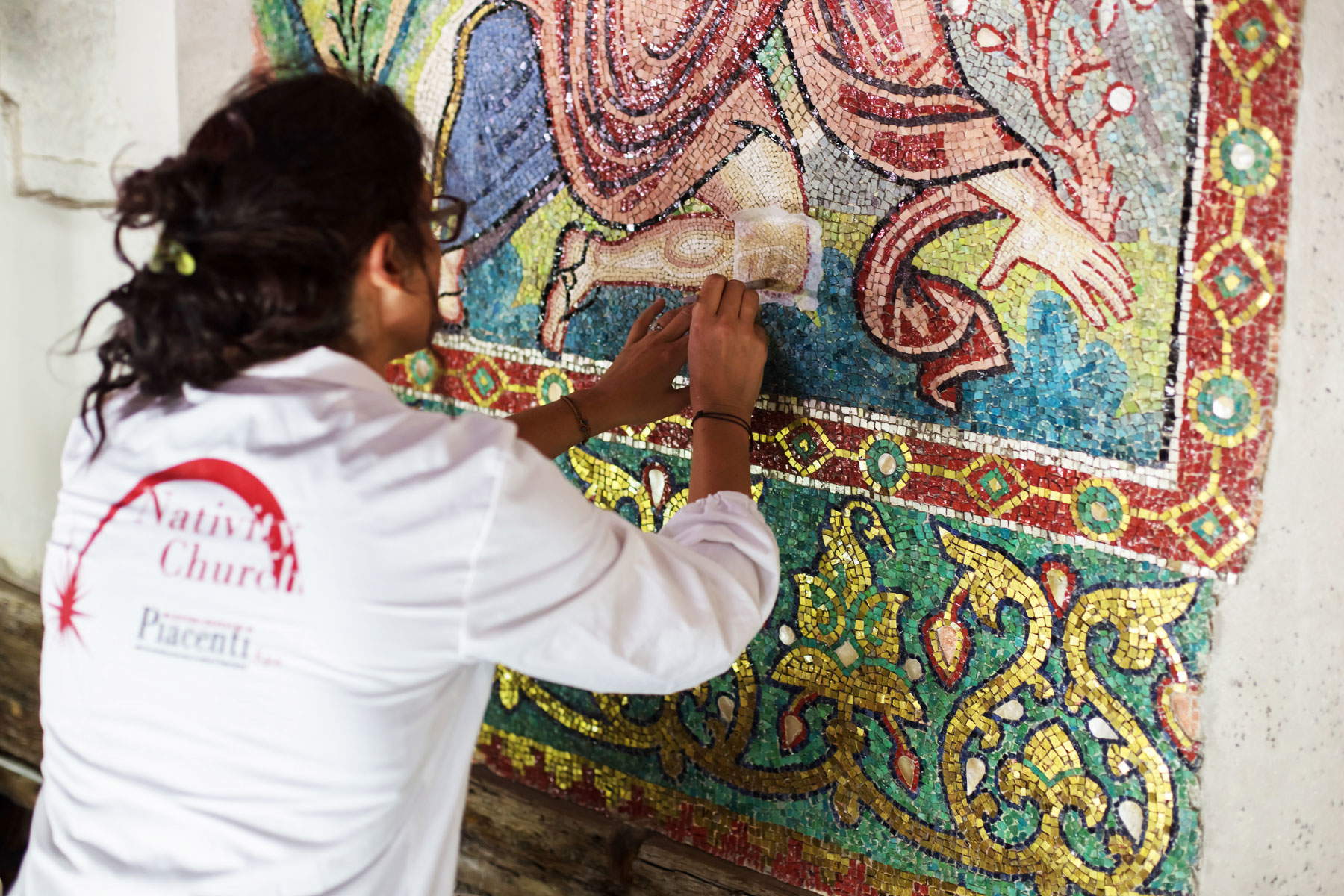
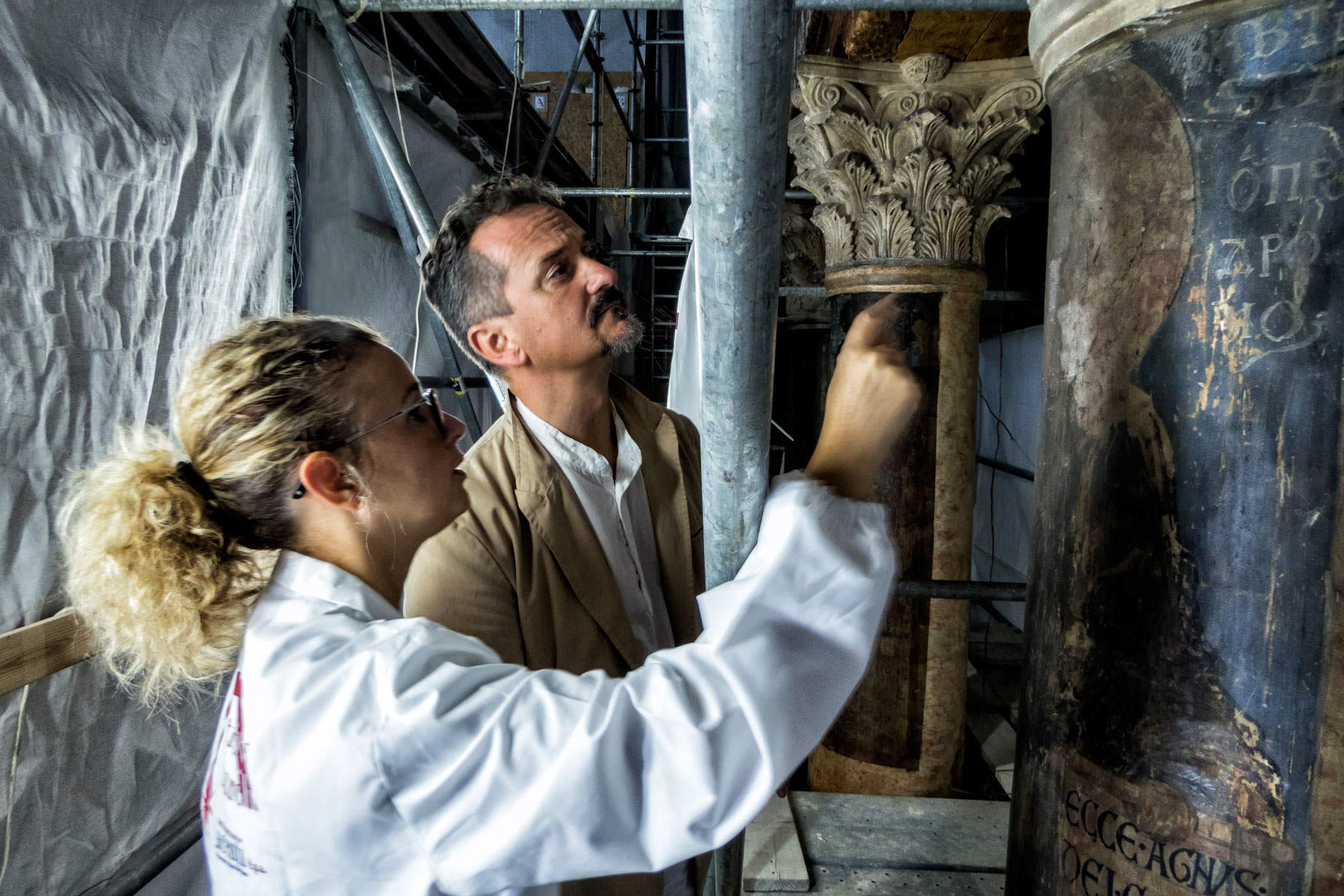


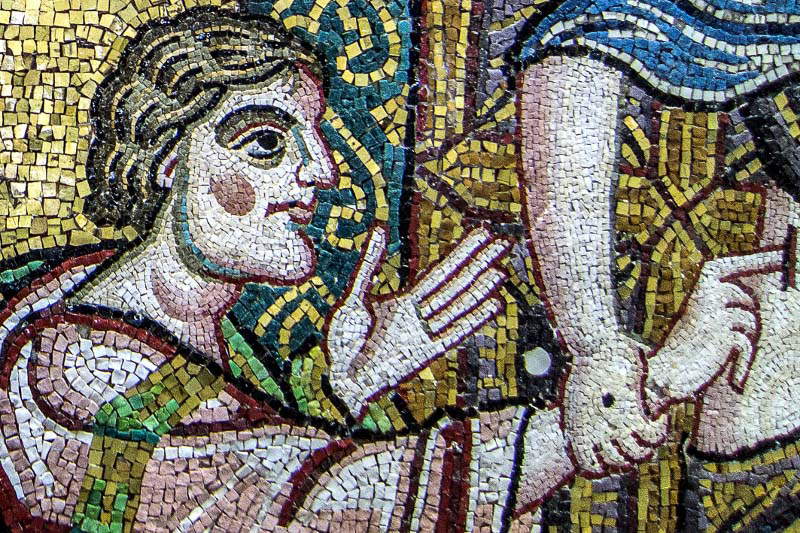

“The distinctiveness and also the extraordinariness of this complex from the art-historical point of view,” explains art historian Michele Bacci, “lies in the fact that one cannot simply label it as Byzantine, Western, or Islamic but that it contains elements of the of these 3 different traditions often used selectively.” In fact, the Basilica of the Nativity in Bethlehem is a very layered monument: its origin is due to the Emperor Constantine ’s desire to construct majestic buildings in places related to the salient episodes of Jesus’ life, particularly birth, death, and resurrection, so that pilgrims would come to the Holy Land to visit them. The Holy Sepulcher complex brought together the sites of the Crucifixion and Resurrection, while in Bethlehem he had a great basilica built at the cave of the Nativity. The latter is considered the centerpiece of the basilica: a gallery about ten meters long, in the eastern end of which a silver star is located in a small niche indicating the spot where Jesus was born, while in one corner is the spot where the Child was placed in the manger. According to an ancient ritual, moreover, on the altar of the grotto where Our Lady gave birth to baby Jesus, Muslim women kneaded bread to be given to parturients to relieve them of the pains of childbirth; Bethlehem in fact means “the house of bread.”
The first record of the newly consecrated basilica for worship is by the so-called Anonymous of Bordeaux and dates back to the year 333. Of the ancient Constantinian church is the large mosaic carpet in the nave and north transept, which features decorations with plant, geometric and animal motifs, and in the center of a small portion of the remaining mosaic one can read the Greek word ICHTYS, a Greek acronym whose initials indicated the formula “Jesus Christ, Son of God, Savior” used by the early Christian communities.
According to tradition, the Constantinian Basilica was destroyed following the revolt of a group of Samaritans who burned down many churches in Palestine in 529. The reconstruction was the work of King Justinian: it was to be a splendid, large and beautiful church, the likes of which were not even to be found in Jerusalem. In fact, recent archaeological investigations have shown that the destruction of the ancient church would have been linked to Justinian’s plan to rebuild the church from the ground up. The new basilica had a monumental facade with three ornate portals, and inside it was divided into five aisles that were in turn divided by four rows of monolithic columns, on which there were Corinthian capitals covered with gold. And to access the grotto, two new stairways had been built through which pilgrims could physically enter the grotto and bow before the silver star and in front of the manger.
During the Crusader era, in the 12th century, the Basilica was transformed into a fortress with the addition of a monastery and hospices to provide hospitality for a growing number of pilgrims. However, the most significant change occurred inside, with the renovation of the decorative mosaic apparatus: this was in the year 1169. Commissioners were the Byzantine emperor Manuel Comnenus, the king of Jerusalem Amalric I and the Latin bishop of Bethlehem Raoul: these proclaimed themselves direct heirs of Constantine and Justinian. The mosaics bear the names of their authors, Ephrem and Basilius, who were very familiar with Byzantine art, from which they drew inspiration for the rendering of faces and the volume of drapery, and Islamic art, evidenced by frequent references to ornamental motifs from the Dome of the Rock in Jerusalem and a notable use of mother-of-pearl. The nave depicted Christ’s genealogy, ecumenical councils and provincial synods, and, between the windows, seven angels accompanying pilgrims on their mystical journey to the holy grotto. In the apse was Our Lady between Abraham and David, while in the transepts were scenes from the life, Passion, and Resurrection of Christ, such as the Entrance into Jerusalem (with a festive crowd welcoming Jesus and children spreading robes and palm branches on the ground), the Incredulity of Thomas (with the striking detail of Christ’s hand accompanying Thomas’s finger on the wound), and the Ascension with the Virgin in the center and angels around. Beginning in 1130 then, as previously mentioned, the columns of the nave were painted with saints and prophets commissioned by the faithful who had devoutly come to the Basilica so as to reach the grotto guided by their patron saints. “The uniqueness of this building,” Bacci goes on to explain, “is the fact that it forms a kind of enormous monumental frame to what is the actual holy place. In its period of greatest splendor, that is, around 1169-1170, the church was entirely covered with mosaics in the upper part of the walls, that is, from the counterfacade along the nave and again, seamlessly, in the transepts and in the apse area.”
All these mosaic and pictorial works needed comprehensive restoration, thanks to which today it is still possible to admire these wonders dating back many centuries, and especially thanks to which future generations will be able to continue to see the place where Jesus was born, charged with emotion.
Warning: the translation into English of the original Italian article was created using automatic tools. We undertake to review all articles, but we do not guarantee the total absence of inaccuracies in the translation due to the program. You can find the original by clicking on the ITA button. If you find any mistake,please contact us.